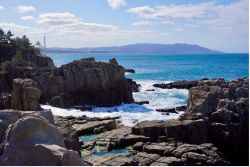
January 18, 2013
Under The Radar
Tokyo’s unsung creative women fuel ventures across the arts
By Metropolis

Yuri Manabe is a young photographer who has created many photo books inspired by her travels. Moving along the US West Coast, Manabe photographed the scenery as well as the people she met within the queer communities. As a traveller, Manabe is aware of the “wall” that many people place in front of themselves when they meet a stranger.
“Even I have this wall. However, through photography, I can sneak past it.”
When we saw her photo books, we asked if she did any self-portraits. “No. It’s always from me, looking out.” Her photo books are beautifully constructed pieces in limited edition. Despite the sophisticated compositions, combining landscape shots and the people she’s met along the way, Manabe uses the rough photocopy aesthetic of zines by printing her images on recycled paper in black-and-white.
Welcome to Dykes’ Mountain is a new take on a well-worn path. “My friends and I climbed Mount Fuji. We joked around and said, since we have conquered it, we should claim it for all dykes.” Manabe’s photo books are published and released through Lilmag (see below).

Momo Nonaka is the multi-skilled owner of the aforementioned Lilmag, a small publishing and distribution label. By trade, she is a writer, editor and translator for various publications, including the Japanese edition of Girl Zines: Making Media, Doing Feminism (written by Alison Piepmeier).
Through Lilmag, Nonaka has been supporting the underground, independently published zines of many Tokyo writers and artists. Lilmag is behind the annual Tokyo Zinestar Gathering held at Pool, a (literally) underground venue in Sakuradai. The festival is a great opportunity to see some of Tokyo’s most interesting zines and their creators.
Lilmag also trades in minikomi (mini-communications, a Japanese name for amateur books and magazines), artists’ books, photo books (like Yuri Manabe’s), the world of dojinshi (amateur manga), art and sound, craft and DIY, and more. “I know it is too broad,” Nonaka admits on her website.
Lilmag’s guide (in Japanese), the Comic Reader for Girls, Boys and Grown-Ups is a unique introduction to the world of manga; eschewing a division of titles into categories based on gender or age. Nonaka feels manga can be enjoyed by anyone. The Comic Reader is illustrated with the adorable characters of Yuutan, the pen name of the author of Lilmag’s charming manga series, Yocchi. Nonaka’s vast array of independent publications can be viewed at her website, http://lilmag.org.
While Yocchi is filled with cute girls and cats, on the other side of the coin, Lilmag also introduced us to Roadside Witch Society, a slickly drawn manga imbued with biting social commentary. At a recent exhibition at Shinjuku’s underground hangout, Irrational Rhythm Asylum, creator Namikuso displayed her original manga manuscripts alongside English translations. Her drawing style shows the influence of American graphic novelists like Daniel Clowes of Ghost World, but draws deeply on the experience of being a feminist in Japan. There’s a great deal of mention of riot grrls as well as plenty of colourful Japanese slang. Namikuso’s manga exists on paper through Lilmag and online via her blog, http://namimangamange.blogspot.jp.

Junko Harada is another long-time member of one of the Jimbocho collectives (one of the people who runs Rojitohito), who is also active as a banner-maker and all-around designer for anti-nuclear protests. Harada and her friend Zaboten work as a duo under the name Bohemian Punch [pictured]. It’s a recent pairing that has seen the two collaborate on performances and props. Banners appeal to them because of their close association with political movements and street protests throughout history. Most of the Bohemian Punch banners are statements against the use of nuclear energy in Japan. Other props include drums, trumpets, and elaborate hand-sewn costumes. Their aim is to make street protests a creative opportunity as well as a practical message. A video of one performance can be seen on their blog; titled Women in Black, it features the duo in long black dresses and black veils, while anonymous figures carry banners, illustrations of radioactive symbols, and a picture of former prime minister Noda. Their activities are documented online at http://bohemianpunch.tumblr.com.

Yumiko Hayakawa is a friend of Harada and a filmmaker who knows how important women have been in the anti-nuclear movement since March 2011. Her previous projects have been full-length documentaries, such as Brian and Co. Parliament Square SW1 (2009). A new project documents the political actions of Onnatachi no ippyou ikki (Women Vote and Revolt)—a movement that has seen groups of women camping in front of the Ministry of Economy, Trade and Industry. Mostly from Fukushima, the protesters are making a stand against Japanese big business and the government in the interest of the environment and people’s safety.
Normally, a documentary takes a long time to film and then edit. “But when thinking of this Fukushima disaster, I can’t be so patient,” Hayakawa explained, “because the situation now and the situation one year later will be so different, and people are being irradiated while I am filming and editing. So, I decided to have a style where I shoot and… then I upload them onto YouTube fairly quickly.”
Hayakawa talked about how much she has enjoyed meeting the anti-nuke women protesters. “They speak out, express their true feelings in their own ways. I believe in the power of women to change our use of nuclear power and prevent more disasters.”
Hayakawa’s film-in-progress can be followed on YouTube and her film company’s website, http://petiteadventurefilms.com.





